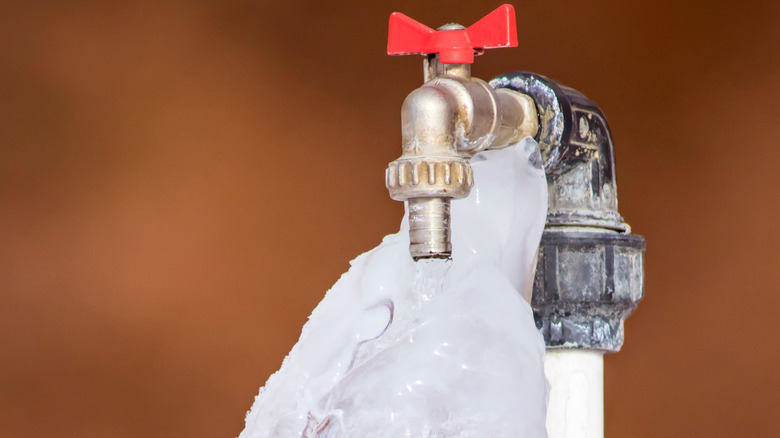How to Avoid Frozen Plumbing in Cold Weather: Professional Tips
How to Avoid Frozen Plumbing in Cold Weather: Professional Tips
Blog Article
Just how do you feel on the subject of Preventing and dealing with frozen pipes?

Winter can wreak havoc on your pipes, particularly by freezing pipelines. Here's just how to avoid it from occurring and what to do if it does.
Introduction
As temperature levels decline, the risk of icy pipelines rises, possibly leading to costly repairs and water damage. Recognizing exactly how to avoid frozen pipes is essential for homeowners in chilly climates.
Prevention Tips
Insulating at risk pipes
Cover pipelines in insulation sleeves or use warm tape to safeguard them from freezing temperature levels. Focus on pipes in unheated or outside locations of the home.
Heating methods
Maintain indoor spaces effectively warmed, especially areas with pipes. Open up closet doors to permit cozy air to circulate around pipes under sinks.
Exactly how to recognize icy pipelines
Search for reduced water circulation from faucets, uncommon smells or noises from pipelines, and noticeable frost on subjected pipelines.
Long-Term Solutions
Architectural adjustments
Think about rerouting pipes far from exterior wall surfaces or unheated areas. Include added insulation to attics, cellars, and crawl spaces.
Upgrading insulation
Buy top quality insulation for pipelines, attics, and wall surfaces. Correct insulation assists keep consistent temperature levels and reduces the danger of icy pipelines.
Safeguarding Exterior Pipes
Garden hose pipes and outside faucets
Separate and drain garden tubes prior to winter season. Set up frost-proof spigots or cover outdoor taps with shielded caps.
Recognizing Frozen Pipelines
What triggers pipes to ice up?
Pipes freeze when revealed to temperature levels below 32 ° F (0 ° C) for prolonged periods. As water inside the pipes freezes, it broadens, putting pressure on the pipeline walls and possibly creating them to burst.
Dangers and damages
Frozen pipelines can result in water disturbances, residential property damages, and costly fixings. Ruptured pipes can flood homes and create substantial structural damages.
Indications of Frozen Pipeline
Identifying icy pipes early can stop them from rupturing.
What to Do If Your Pipes Freeze
Immediate activities to take
If you presume frozen pipelines, keep faucets open to eliminate pressure as the ice thaws. Use a hairdryer or towels soaked in warm water to thaw pipes gradually.
Verdict
Avoiding icy pipes needs aggressive measures and quick actions. By understanding the causes, indications, and safety nets, homeowners can safeguard their pipes throughout winter.
6 Proven Ways to Prevent Frozen Pipes and Protect Your Home
Disconnect and Drain Garden Hoses
Before winter arrives, start by disconnecting your garden hoses and draining any remaining water. Close the shut-off valves that supply outdoor hose bibs and leave the outdoor faucet open to allow any residual water to drain. For extra protection, consider using faucet covers throughout the colder months. It’s also important to drain water from any sprinkler supply lines following the manufacturer’s directions.
Insulate Exposed Pipes
Insulating your pipes is an effective way to prevent freezing. Pipe insulation is readily available at home improvement stores and is relatively inexpensive. Pay close attention to pipes in unheated areas such as the attic, basement, crawl spaces, or garage. Apply foam insulation generously to create a buffer against the cold. You can also wrap your pipes in heat tape or thermostat-controlled heat cables for added warmth.
Seal Air Leaks
Inspect your home for any cracks or openings that could let in cold air. Seal any holes around the piping in interior or exterior walls, as well as the sill plates where your home rests on its foundation. Additionally, make sure to keep your garage door closed unless you’re entering or exiting. Leaving it open creates a significant air leak that can lead to frozen pipes.
Allow Warm Air Circulation
During cold snaps, it’s essential to allow warm air to circulate evenly throughout your home. Leave interior doors ajar to promote better airflow. Open kitchen and bathroom cabinets to help distribute heat consistently around the rooms. If you have small children or pets, be sure to remove any household chemicals or potentially harmful cleaners from open cabinets for safety.
Let Faucets Drip
A small trickle of water can make a big difference in preventing ice formation inside your pipes. When temperatures drop significantly, start a drip of water from all faucets served by exposed pipes. This continuous flow helps prevent the water from freezing. Additionally, running a few faucets slightly can relieve pressure inside the pipes, reducing the chances of a rupture if the water inside does freeze.
https://choateshvac.com/6-proven-ways-to-prevent-frozen-pipes-and-protect-your-home/

We had been made aware of that report about How to Prevent Your Pipes From Freezing from a friend on our other web blog. Sharing is good. Who knows, you may be doing someone a favor. I am grateful for being here. Please check up our website back soon.
Book Inspection Report this page